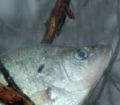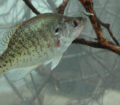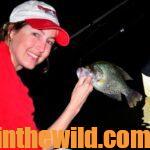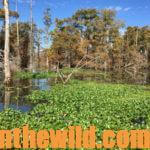Editor’s Note: Whitey Outlaw of Gaston, South Carolina, fishes on Santee Cooper often and also fishes in crappie-fishing tournaments across the U.S. Today Outlaw gives us a February pattern for fishing Santee Cooper Lake that will work in your area on a grass lake.
 JITW: Whitey, yesterday you told us how to catch crappie in a grass lake like the upper end of the Santee Cooper Lake. But how do you catch crappie on the lower end of Santee Cooper Lake in February where there is no grass?
JITW: Whitey, yesterday you told us how to catch crappie in a grass lake like the upper end of the Santee Cooper Lake. But how do you catch crappie on the lower end of Santee Cooper Lake in February where there is no grass?
Outlaw: The lower end of Santee Cooper below the highway 95 bridge is virtually open water. It has a lot of dead standing timber in it, and the bottom averages about 20- to 30-feet deep. When I’m fishing this end of the lake, I’ll start off spider rigging on the main river channel. The crappie use the main river channel as their highways into the creeks and cuts to reach the spawning flats. In February, the crappie haven’t started making their migration back to the spawning flats, due to the cold temperature of the water. I generally start fishing 17-feet deep and troll my jigs about 12-feet deep. Then we let the crappie tell us what to do next.
If we don’t start catching fish at 12 feet, we’ll fish deeper and move farther out on the river channel. At this time of year, we’ll be fishing a number of deep stumps, channels and drop-offs. We’ll have eight rods out, and we’ll be tight-line fishing using a 1/2-ounce lead with a hook below the lead and a hook above the lead. We’re fishing with straight minnows and moving extremely slowly, because if the crappie are holding on the ledges, they’ll come up and take the minnows. You have to fight the temptation of moving too fast at this time of year, because the crappie won’t chase the bait. They’ll just rise slowly in the water and suck-in the minnows. Therefore, you don’t want to take the bait from the crappie while they’re trying to eat it.
JITW: Which poles are you using when you’re tight-lining?
Outlaw: I prefer the 14-foot B‘n’M Buck’s Graphite jig poles (https://www.bnmpoles.com/products/bgjp). I always use these poles when I’m spider rigging. We’ve been using them for quite a few years, they do exactly what we need them to do, and we see no reason to change.
 JITW: What pound-test line are you using when you’re tight-line fishing?
JITW: What pound-test line are you using when you’re tight-line fishing?
Outlaw: Any time I’m tight-line fishing, I fish with 10-pound-test line and an Eagle Claw 214 No. 2 extra-light hook (https://www.eagleclaw.com) with minnows only. I like this hook because if my hook gets hung in a stump, I can pull hard on the 10-pound-test line and straighten-out the hook. Then, when I get it to the boat, I can re-bend the hook, and I don’t have to retie on a new one. We have plenty of stumps and standing timber at the lower end of Santee Cooper. When you’re fishing around that much wood, you’re likely to get hung. So, we use our depth finder to see the stumps, stay on the river or creek channel and find the fish we’re trying to catch. At this time of year, if you’re fishing in 20 feet of water, the crappie are usually holding at 18 feet of water. Therefore I want my baits to run at about 17- to 17-1/2-feet deep, if I’m certain the crappie are concentrated in 18 feet of water. I want to keep that bait just above a crappie, so it doesn’t have to move too far to eat the bait.
JITW: What size will the February crappie be at the lower end of the lake?
Outlaw: The average crappie will weigh 1-3/4- to 2 pounds. The crappie don’t get much bigger than this in Santee Cooper. On Santee Cooper, a 2-1/2-pound crappie is about as big as they get. But don’t expect to come to this lake and catch all 2-pound crappie. You’ll have a good mix of 1- to 2-pound crappie. I don’t know anyone who can fish Santee Cooper and catch large numbers of 2-pound crappie.
 JITW: How many crappie will you and your partner catch in a day of fishing on the lower end of Santee Cooper?
JITW: How many crappie will you and your partner catch in a day of fishing on the lower end of Santee Cooper?
Outlaw: On an average day in February – a very-cold day when the wind doesn’t blow you off the lake – we’ll catch 40- to 50-quality-size crappie. Santee Cooper’s a really-big lake, and it can get rough quickly. However, you can fish it fairly well even in 18- to 20-mile-per-hour winds, if you’re dragging a chain to hold you over the drop-off, and if you tie the boat to the back of a tree where you’re catching fish. But if the area gets winds greater than 18-miles-per-hour, I look for a place to fish out of the wind. This is a long, straight, narrow lake that’s 40-miles long and 5-miles wide in some places. Sometimes finding a place to get out of the wind can be difficult there.

 To learn more about crappie fishing, see John E. Phillips’s books in Kindle, print and/or Audible forms, including, “Crappie: How to Catch Them Spring and Summer” (http://amzn.to/WGaJLT). To receive and download for free “The Crappie Catchers’ Cookbook,” by John and Denise Phillips, go to https://johninthewild.com/free-books.
To learn more about crappie fishing, see John E. Phillips’s books in Kindle, print and/or Audible forms, including, “Crappie: How to Catch Them Spring and Summer” (http://amzn.to/WGaJLT). To receive and download for free “The Crappie Catchers’ Cookbook,” by John and Denise Phillips, go to https://johninthewild.com/free-books.










